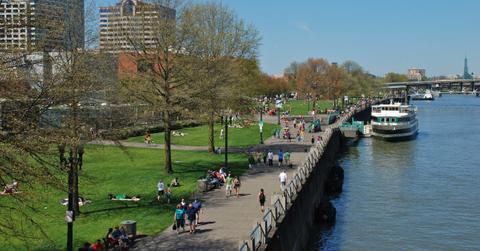Coastal Cities Consider Waterfront Parks Over Sea Walls To Combat Flooding
Boston and Norfolk are two of the U.S. cities managing rising sea levels and increased flooding with brand new parks.
Updated Nov. 8 2018, 1:58 p.m. ET
Cities along the coast have typically relied on sea walls to keep the ocean out. These concrete and steel embankments mitigate flooding when storms whip the waters onto land, and they currently protect the residents of countless ocean-adjacent towns.
But according to Stateline, U.S. city leaders are reconsidering their flood defenses. Instead of sea walls, they’re increasingly opting for waterfront parks that welcome the tides in and pose less of a threat to local marine life.
The idea of opening the coast to stormy waters rather than blocking them with a large, solid wall is central to the Dutch approach to flood management. The Netherlands has long preached living with — rather than fighting — water, but the concept is now catching on in America. City planners like the idea because it gives them a better opportunity to divert the flooding wherever they want it to go, all while avoiding some of the issues that are typically attached to sea walls: Coastal erosion, soaring costs, and interference to turtle nesting.
Boston is one of the larger cities ditching sea walls for parks. The New England metropolis originally planned to construct a massive four-mile barrier around the Boston Harbor. But as the projected price climbed to $11.8 billion and UMass researchers warned it was a short-term solution at best, city officials changed their strategy.
Last month, Mayor Martin Walsh announced a new plan to build a network of waterfront parks. Stateline reports these parks would ultimately add 67 acres of green space to the coast — and restore 122 tidal acres. Boston city planners will also elevate certain areas that are more vulnerable to flooding, and put up small-scale barriers, some of which will be removable.
"I'm not sure if any other city in America has quite planned this way,” Walsh told reporters at a press conference on Oct. 15.
“They have after the fact. New Orleans had to plan after Katrina. But we want to get ahead of this game and plan before before something happens like that."
But Boston isn’t alone in its newfound affinity for flood parks. Stateline points to similar projects in Norfolk and Virginia Beach, which have relied on sea walls since the 1960s. With the water levels there rising 14 inches since 1930, the communities are now considering more parks and wetlands.
The rising sea levels and severe flooding spurred by climate change are forcing cities to rethink their commitments to sea walls. Yet Stateline argues that the barriers “may be necessary in some circumstances.” Sea walls are so ingrained in cities along southern Florida that it’s difficult to avoid them entirely. As the older ones crack and crumble, city planners must decide how much to invest in their maintenance and how much to spend on greener alternatives.
Still, the push for waterfront parks is a boon for environmentalists, who worry about the walls’ impact on coasts and marine life, as well as their long-term sustainability. And it’s also a win for city residents, who will be able to enjoy more greenery during the less stormy seasons.
